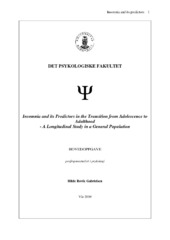Insomnia and its Predictors in the Transition from Adolescence to Adulthood - A Longitudinal Study in a General Population
Master thesis
Permanent lenke
https://hdl.handle.net/1956/3500Utgivelsesdato
2009-04-15Metadata
Vis full innførselSamlinger
- Faculty of Psychology [527]
Sammendrag
This study investigated the course of insomnia from young adolescence to adulthood, and identified early predictors of adult insomnia. Data on sleep, health, and lifestyle factors were collected in 1242 individuals at four time points from at age 13 years to 30 years, in a Norwegian general sample. There was a high stability of sleep problems: of participants with DSM-IV defined insomnia at age 30, 58%, 29%, and 39% also reported sleep problems at age 23, 15 and 13, respectively. Poor health during adolescence was the strongest predictor of adult insomnia, and the strongest individual predictors were pain, poor perceived health, diffuse symptoms, and previous sleep problems. We conclude that insomnia is persistent over time from young adolescence to adulthood, and that several health factors during adolescence predict insomnia at age 30. Denne studien har undersøkt insomni fra ungdomsalder til voksenalder, og identifisert tidlige prediktorer på insomni hos voksne. Data om søvn, helse og livsstils faktorer ble innhentet fra 1242 individer på fire tidspunkt fra de var 13 år til de ble 30 års, i den norske normalbefolkningen. Det ble funnet en høy stabilitet av søvnvansker: av deltagere med DSM-IV identifisert insomni ved 30 år, hadde henholdsvis 58%, 29% og 39% også rapporterte søvnvansker i 23, 15 og 13 års alderen. Dårlig helse som ungdom var den sterkeste prediktoren for insomni hos voksne, og de sterkeste individuelle prediktorene var smerte, dårlig subjektiv helse, diffuse symptomer og tidligere søvn vansker. Vi konkluderer med at insomni er vedvarende over tid fra tidlig ungdomsalder til voksenalder, og at flere helse faktorer i ungdomsalderen predikerer insomni ved 30 år.
Utgiver
The University of BergenOpphavsrett
Copyright the author. All rights reservedThe author
